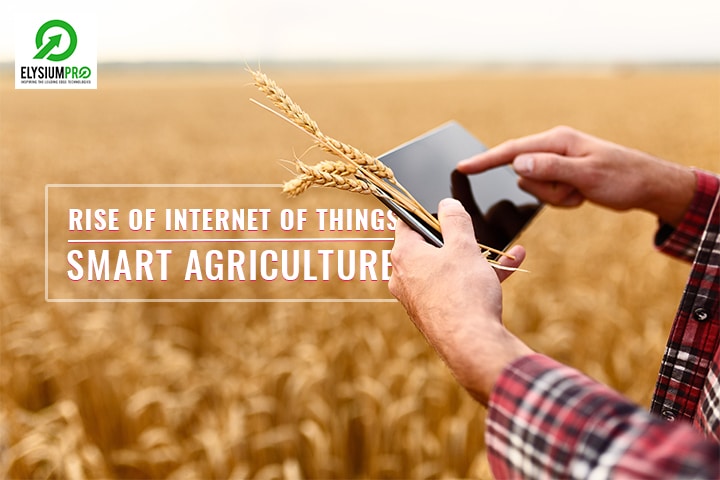- 24/7 Support Center
- +91 9944793398
- 0452 4390702
- info@elysiumpro.in
Rise of Internet of Things in Smart Agriculture

Development of Python – Trending High For 2020
February 20, 2020
9 Emerging Industrial IoT Trends in 2020
March 2, 2020Table Of Content
- Introduction
- IoT-Based Smart Agriculture Cycle
- Observation
- Diagnostics
- Decisions
- Action
- Benefits of IoT in the Agriculture Sector
- Monitor Climate Conditions
- Crop Management
- Livestock Farming
- Smart Greenhouses
- Agriculture Drones
- Self-Driving Farm Vehicles
- Farm Management Systems
- Final Thoughts
Introduction
Benefits of IoT in Agriculture: With the improving adoption of the Internet of Things, connected devices have penetrated each aspect of our daily lives, from health to fitness, home automation, logistics, to connected cars and industrial IoT projects.
Therefore, this is the only logical that IoT, connected devices and automation can find its application in agriculture sector. It helps to enhance every facet of it. As a matter of fact, Smart Farming is an interesting concept which refers to maintaining farms using modern information and communication technologies to improve the quantity and quality of products while optimizing the human labour required.
In these days, the modern technologies have been revolutionized in every sector and agriculture is no exception. Generally, smart farming using IoT can provide more efficient farming techniques and transform the agriculture sector.
IoT-Based Smart Farming Cycle
As a matter of fact, the primary core of IoT is the data that you can draw from things (T) and transmit through the Internet (I). In fact, to optimize the farming process, IoT sensor installed on a farm which gathers and process data in the repetitive cycle which allows the farmer to react quickly to emerging problems and changes in ambient conditions. Smart agriculture follows a cycle method like
- 1. Observation
- 2. Diagnostics
- 3. Decisions
- 4. Action
1. Observation
As a matter of fact, sensors record observational data from the soil, crops, livestock, and atmosphere etc.
2. Diagnostics
The sensor values are fed to a cloud-hosting IoT platform with predefined decision rules, and models are known as business logic, the condition of the examined object and determine any needs.
3. Decisions
Afterwards, problems are revealed, the user and machine learning components of the IoT platform that identify whether location-specific treatment is necessary.
4. Action
Finally, the end-user evaluation, the process repeats from the beginning.
Benefits of IoT in the Agriculture Sector
Here, there are top 7 benefits of IoT in the agriculture sector such as
- Monitor Climate Conditions
- Crop Management
- Livestock Farming
- Smart Greenhouses
- Agriculture Drones
- Self-Driving Farm Vehicles
- Farm Management Systems
Monitor Climate Conditions
In common, the most popular smart agriculture gadgets are weather stations, combining several smart farming sensors. In fact, located across the field, they gather several data from the environment and send it to the cloud. However, the provided measurements will use to map the climate conditions, choose the appropriate corps and take the required measures to enhance the capacity.
Crop Management
An element of precision farming is crop management devices. Like the weather stations, they will place in the field to gather data to crop farming; from temperature to leaf water potential and crop health. Therefore, you can manage and maintain the growth of crop and anomalies to prevent any diseases that can harm your field.
Livestock Farming
In that case, a smart farming technique allows farmers very better to manage the needs of individual animals and helps to adjust their nutrition. Thereby, it prevents disease and improving herd health. Major farm owners use IoT applications which is useful to monitor the location, well being and health of their cattle. With the help of these details, they determine sick animals. Therefore they can be separated from the herd to prevent the spread of diseases.
Smart Greenhouses
Traditional greenhouses can manage the environmental parameters via manual intervention. It often results in less production, energy loss and also labour cost. In fact, the IoT stats 2020 driven smart greenhouses can monitor smartly as well as it controls the climate, deducts the need for manual intervention. Several sensors can measure the environmental parameters which according to the particular crop requirements. That data is stored in a cloud-based platform for further processing and control with the minimum manual intervention.
Agriculture Drones
To determine, agriculture is one of the important verticals to integrate both ground-based and aerial drones. It is used for crop health assessment, crop monitoring, spraying, irrigation, field analysis etc. The drones can gather multispectral, thermal, and the visual imagery while flying, the data they collect deliver the farmer along with insights into the array of metrics such as plant health indices, yield prediction, measurement of plant height, plant counting, field water pond mapping, reports, chlorophyll measurement, weed pressure mapping etc.
Self-Driving Farm Vehicles
In general, an autonomous vehicle does not apply to transportation. Rather, self-driving tractors provide the primary example of a smart farming system. Where autonomous tractors helps the farmers are in lowering labour costs. Because self-driving farm vehicles will continue operating 24/7 and there is an increased efficiency. Therefore, autonomous farm vehicles will tackle not only low production but labour shortage issues as well.
Farm Management Systems
The farm productivity management systems will represent the complex method of IoT products in agriculture. Usually, it consists of the number of agriculture IoT predictions and sensors, and is installed on the premises. As well as, the powerful dashboard with analytical capabilities and in-built features. It provides remote farm monitoring capabilities, and it helps to allow streamline most of the business operations—additionally, some prominent opportunities such as vehicle tracking, storage management and logistics etc.


